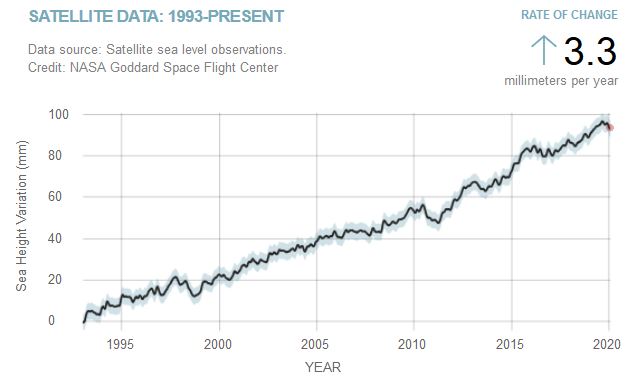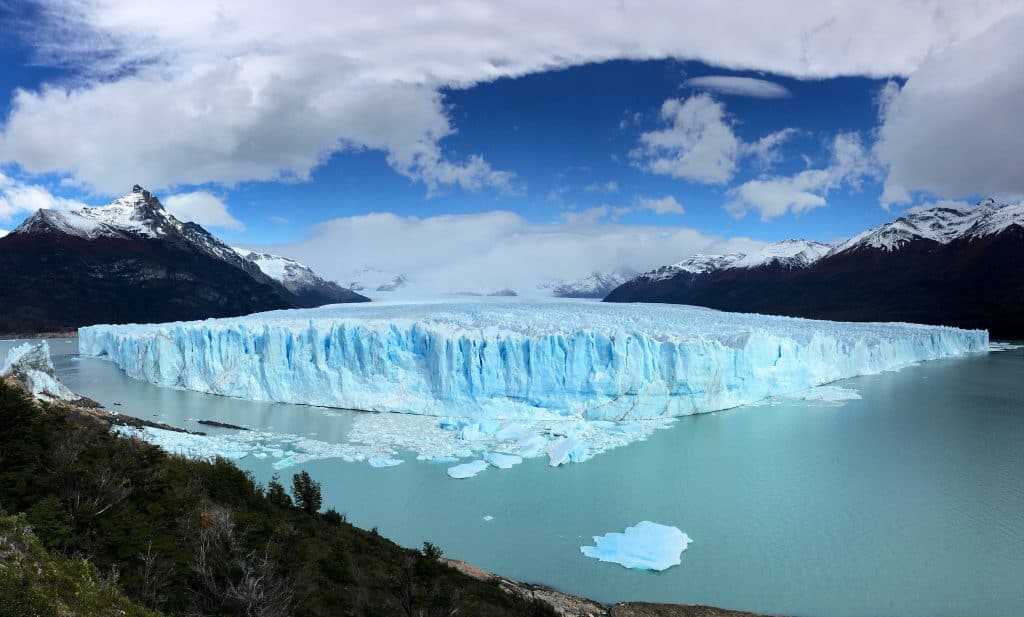The threat of sea level rise to Kiribati

With the current pandemic, it’s easy to forget the other crisis we’re dealing with. The Coronavirus halted our global society, but not climate change. Green house gases are still emitted to keep us up and running. One of the effects of climate change is sea level rise. If you live in the mountains, this is obviously not a problem. But if you live close to the coast, sea level rise might become a threat. Some countries are even at risk of disappearing. We’ll introduce you to Kiribati, possibly the first country to disappear because of sea level rise.

Source: https://climate.nasa.gov/vital-signs/sea-level/
What’s happening in Kiribati?
Kiribati is a paradise looking country, located in the Pacific Ocean. Actually, the country consists of 33 islands, spread out over the size of India [1]. The islands are often only a few meters above sea level. Because of sea level rise, the islands experience more flooding and the soil is slowly washing away. Slowly, the islands are disappearing, some say they might be gone within a few decades. Already, many people migrated to saver places elsewhere on the islands [2].
The people of Kiribati have lived with the oceans for centuries, with elders passing on traditions to new generations. Inhabitants are driven to sustain their livelihood, but many problems are brought with sea level rise. With the increased flooding, freshwater resources become scarce. Ocean heating might cause coral bleaching around the islands [3]. Without international support, it is unlikely that Kiribati and its people can survive.
Solutions
Luckily, other countries and organizations noticed the urgent need for help. The past decades, some adaptation programs were initiated to protect the islands. For example by building sea walls [4,5]. However, these programs were not incredibly effective.
An alternative solution is to migrate the inhabitants to other countries. But, this means a loss of culture and connection. The people of Kiribati would then become climate refugees. There is only one problem: this type of climate refugees is not acknowledged yet by the UN [6]. In 2015, Ioane Teitiota applied for residency in New Zealand, as he felt his home in Kiribati had become unsafe due to sea level rise. His application was rejected. Many countries are not eager to take in refugees. Both strategies are therefore no quick solutions.
Sea level rise
So why do we actually have sea level rise? There are two main reasons for that: ocean thermal expansion and glacier melt [7]. Just like many substances, water expands when heated [8]. As the oceans have absorbed 90% of all extra heat in the atmosphere, we see this thermal expansion in the oceans. Secondly, with rising temperatures, land ice and glaciers start to melt. Glaciers contain 2.1% of all water on this planet, imagine that ending up in the ocean [9]!

The future of coastal communities
In our previous article, we discussed that the oceans provide us with many services. It is no surprise that many people choose to live close to the oceans. 40% of our world population, that is around 2.4 billion people, live within 100 kilometres of a coast. Of them, 600 million people (around 10% of the world population) live in areas that are less than 10 meters above sea level [10].
In the worst-case climate scenario, this 21st century will have a sea level increase of about 0.74 meters. That is on top of the centimetres gained in the 20th century [7]. This means that many people worldwide need to move in the coming decades, maybe you too!
Kiribati is just one example of many countries and communities worldwide that are suffering from sea level rise. This also leads to a decrease of freshwater resources, loss of agricultural activity due to salt contamination and erosion of land [11]. It becomes clear that change is needed. It remains everyone’s responsibility to do something about sea level rise. Together we must limit our carbon footprint, and look for solutions.
TIPS to reduce your carbon footprint:
- Eat local! Now that the world is in lock-down, we must stay close to home. Have a look around for local farmers that sell their products. Shipping/flying food around the world leads to a lot of emissions.
- Especially in these times, people are aware that far travelling is not necessary. When you go on holiday, stay close to home and take the train (or bike!). Flights emit a lot of CO2. Curious how this relates to the emissions of other people? Check it here!
What do you think we can do to help Kiribati? Leave your ideas in the comments!
Sources:
[1] https://www.cia.gov/library/publications/the-world-factbook/geos/kr.html
[3] http://www.climate.gov.ki/effects/fresh-water-supply/
[4] http://www.climate.gov.ki/kiribati-adaptation-program/
[5] https://projects.worldbank.org/en/projects-operations/project-detail/P112615
[6] https://www.climatechangenews.com/2020/01/29/un-ruling-climate-refugees-gamechanger-climate-action/
[8] https://sealevel.nasa.gov/understanding-sea-level/global-sea-level/thermal-expansion
[10] https://www.un.org/sustainabledevelopment/wp-content/uploads/2017/05/Ocean-fact-sheet-package.pdf
[11] https://www.nationalgeographic.com/environment/global-warming/sea-level-rise/
Seguo sempre con attenzione gli articoli pubblicati perché li trovo di grande interesse e molto istruttivi specie per chi è vicino a questi enormi problemi ambientali. Grazie per queste preziose informazioni.